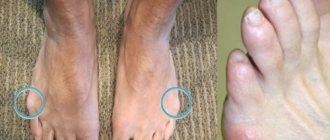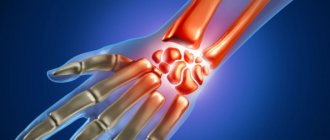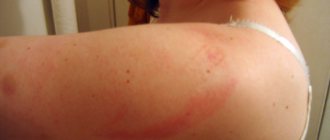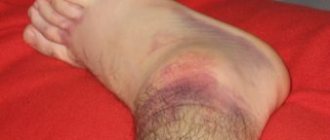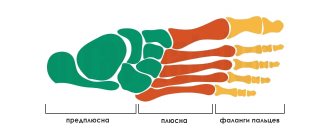- Difference from fracture
- Drug therapy
A bruised toe is a common household injury, and less commonly a sports injury. It is characterized by damage to the soft tissue of the toe and appears as an area of swelling, bluishness and hemorrhage that can sometimes extend to the foot area. The injury is usually accompanied by severe pain and limitation of movements.
A bruised toe usually occurs due to a household or sports injury.
A bruise occurs as a result of heavy objects falling on the toes, hitting hard objects (for example, the legs of a table, chair, sofa), while working or playing sports.
Often with severe bruises, due to similar symptoms, it is difficult to make a differential diagnosis between a bruise and a fracture. Therefore, if you receive an injury, you must seek help from an emergency room or other medical institution, where an orthopedic traumatologist will conduct an examination, prescribe additional tests, correct treatment, and give recommendations.
Characteristic
A bruise of the little toe is a closed injury of the fifth toe, which is characterized by damage to soft tissues and capillaries without compromising the integrity of the skin. The damage can be minor if there is a slight impact on a hard surface and severe if a weighty object falls on the little finger.
The fifth finger is not involved in active movements, but given its anatomical location, it is not surprising that the little finger is often injured. Usually the entire surface of the finger is bruised, while the small nail plate is also involved in the pathological process. The nail may crack, change color, or peel off as a result of injury.
What to do if the nail plate detaches?
If, as a result of a bruise, partial detachment of the nail occurs, then you need to:
- properly treat the injured area using a solution of Lidocaine or Novocaine,
- carefully return the torn nail plate to its physiological position and bandage it,
- regularly lubricate the sore spot with healing compounds (you can use pharmaceutical products or ointments made with your own hands according to folk recipes).
You cannot completely remove a nail if it is partially torn. The patient is categorically not recommended to set a finger with his own hands if he has knocked it out, to take medications on his own, or to use folk recipes. The treatment of the disease should be carried out by a medical specialist.
Clinical manifestations
Trauma can have manifestations of varying severity. The brightness of the clinical picture depends on the force of the blow, the angle of its application, and the presence of protection (shoes) on the leg at the time of injury. The further course and speed of recovery is a direct consequence of the severity of the lesion.
Main features:
- A bruised little toe is always accompanied by severe pain, which changes in character and intensity within a short period of time after the injury. At the moment of impact, the pain impulse is piercing; the reason for the pronounced manifestation is the high concentration of nerve endings on the surface of the finger. After a few minutes, the pain loses its strength, and after two hours it becomes muffled and aching. Repeated intensification of pain symptoms may occur when swelling appears (pressure is created on the nerve endings) or when trying to move a finger.
- Swelling does not occur immediately; after a few hours the finger becomes very swollen. Swelling is rarely isolated, spreading to surrounding tissues. At the same time, the skin becomes very stretched and shiny. The swelling can persist for up to two days, after which the little finger gradually takes on its previous shape.
- When the little finger is bruised, the skin turns red. After a while, the color changes to dark blue, and in case of severe injuries, almost black. This is due to damage to the capillary network, which leads to a hematoma. Subcutaneous hemorrhage usually involves not only the entire surface of the finger, but also spreads to adjacent tissues of the foot. The bruise can involve the area under the nail plate, after which the nail falls off, and a new one will grow in its place for a long time.
- The mobility of the little toe in the event of a bruise is preserved; a reduction in the range of movements is observed with the development of swelling or damage to the muscle that is responsible for the abduction of the fifth toe.
In case of minor injuries, the general condition does not suffer, but difficulties with movement cause inconvenience. While walking, when the body weight is transferred to the foot with the damaged toe, pain occurs. A person spares a bruised leg, as a result of which lameness develops.
Injury resulting from a strong blow to the finger can lead to a deterioration in the general condition. This fact is due to different pain thresholds in people. The body of some victims may respond with a painful shock, a sharp drop in blood pressure, tachycardia, and sometimes loss of consciousness.
Anatomical and physiological features
Each toe has its own name: big, index, middle, ring and little fingers. All of them, except the thumb, consist of 3 tubular bones called phalanges: proximal (main), median and distal (end). The thumb has only 2 phalanges: proximal and distal. The phalanges have articular surfaces, where they are connected to each other by movable joints.
The bones of the toes are surrounded by a layer of fiber containing nerves and blood vessels
Each bone is surrounded by a layer of fiber, in the thickness of which, on the sides of the phalanges, there are vessels and nerves that provide innervation and blood supply to this area. On the dorsal and plantar surfaces there are tendons attached to the nail and middle phalanges.
In terms of the degree of innervation and blood supply, the lower extremities are inferior to the upper extremities. This especially needs to be taken into account for bruised toes in elderly patients and people with the following diseases:
- diabetes;
- atherosclerosis;
- obliteration of arteries;
- varicose veins of the legs;
- other concomitant diseases that impair blood flow in the lower extremities.
In the absence of adequate first aid and proper treatment, patients with these pathologies increase the risk of complications, development of trophic ulcers, bacterial and fungal infections, etc.
The trigger mechanism leading to disarticulation or amputation at various levels of the lower limb in patients with diabetes mellitus is bruised damage to these parts, especially with a violation of the integrity of the skin.
Another feature is the presence of denser skin compared to the skin of the fingers. This aggravates the course of bruised wounds, due to increased tension in the damaged area and increased pain.
Functions of the toes
Being an important part of the musculoskeletal system, the toes perform the following functions:
- Maintaining coordination during movement when the center of gravity changes.
- Participation together with the foot in receiving body weight during walking, running and other movements.
Differences between a bruise and a broken finger
A bruised little toe can be an isolated injury or combined with damage to ligaments, muscles, and a bone fracture. Complicated injuries are always accompanied by distinctive symptoms that will help to promptly recognize a complex injury:
- Violation of bone integrity is accompanied by intense pain, which intensifies after injury and does not go away for a long time. If with a bruise the pain stops 3 days after the injury, with a fracture the pain becomes chronic.
- After the fracture, the finger is deformed. This may manifest itself in pathological curvature of the phalanges of the fingers, their displacement or the inverted position of the little finger in an unnatural way.
Complications of toe injuries
Broken toes can lead to dangerous health consequences even when the injury is relatively mild. Without qualified medical care, skin wounds, cracks and bone fractures can provoke the development of the following complications:
- massive hematomas;
- ankylosis (joint immobility);
- deformation of finger joints;
- formation of bone callus;
- sepsis;
- secondary infections.
Damage to the soft and hard tissues of the extremities is especially dangerous for patients who suffer from metabolic disorders and chronic diseases, in particular diabetes. For such patients, even a minor injury can pose a hidden threat.
First aid
As part of first aid, you should adhere to the general algorithm of actions for bruises:
- Free the injured area by removing your shoes. This must be done carefully so as not to cause additional injury through rough actions.
- Ensure rest of the injured limb.
- Apply ice to the bruised finger, but for no more than 10 minutes. A hypothermic first aid bag, a cloth soaked in cold water, or frozen foods are suitable as cold.
- If there is no deformation of the finger, fix the little finger by connecting it to the adjacent fingers using a narrow adhesive plaster.
- In case of severe pain, give the victim analgesics - Ketanov, Baralgin, Analgin.
- Take the patient to the trauma center for a medical examination.
The outcome of an injury often depends on the correct actions. When providing first aid, you should not rub or move the bruised finger, press on the nail, or try to forcibly remove the torn nail plate. It is forbidden to wipe the skin with alcohol solutions, apply warming ointment and make a compress.
Distinctive symptoms
Hematoma on the little toe
A bruise on the little toe has its own distinctive signs. The main one is severe pain. But you need to know the symptoms of a bruise in order to distinguish such damage from other injuries.
Main symptoms of bruise:
- Sharp pain of a pulsating nature in the place where the leg hit. The pain is especially pronounced in the first 10 minutes after the finger is injured. After this, the pain may continue for several hours or days in the form of aching sensations, often when walking or heavy exertion. This severe pain is explained by the presence of a large number of nerve endings in the toe. If the little finger continues to hurt for more than a few days, this may indicate a dislocation or fracture.
- The damaged little finger swells gradually and swelling appears. Within a few hours or days, the injury site swells and the painful condition may return. The contours of the little finger and knuckles become smooth and continuous, and the skin becomes thin. Swelling can spread to the fingers adjacent to the little toe and to the foot.
- A hematoma occurs at the injured site. A traumatic injury damages the blood vessels, causing the finger to become covered with a hematoma. The skin of the little finger changes its color - first it turns red, and then it may turn blue. The hematoma also often continues, after which the nail plate may peel off.
- The damaged finger retains its motor mobility. Swelling and hematoma may prevent the finger from bending and straightening normally, but in the first minutes after the blow the little finger is able to move. This distinguishes a bruise from a dislocation, as well as from a fracture.
In addition to these symptoms, a person may feel a loss of strength, headache, and generally be in a state of shock.
After receiving an injury, timely primary care is necessary, and only after that you can decide what to do next. For a bruised finger, both medicinal treatment methods and the use of folk remedies are used.
Diagnostics
Timely determination of the type and severity of injury is important for prescribing effective treatment. A bruised little toe is diagnosed by a traumatologist based on clinical signs and patient complaints. Instrumental diagnostics using an X-ray examination will help to exclude a fracture of the little finger bones.
If ligament damage is suspected, magnetic resonance imaging results will be required to assess the condition of the connective tissue. After a detailed examination, the presumptive diagnosis is confirmed and a treatment regimen is drawn up.
Factors causing injury
It is common to receive minor injuries at home as a result of absurd and unexpected accidents. A bruised finger often occurs under various circumstances.
A bruise involves injury to a person’s soft tissues - skin, tendons, muscles. A combined injury occurs quite rarely, when in addition to a bruise there is also a dislocation.
A common cause of injury is sudden impact with a hard surface. For example, almost all people are familiar with such damage as hitting the little finger on the legs of furniture or door frames. Having been hit in this way, a person usually calms down after the pain goes away and does not pay attention to secondary symptoms.
The toes play an important role in maintaining balance when moving. Such an injury manifests itself as unpleasant discomfort, to the point that a person may stop moving.
Therapeutic actions
Therapeutic tactics are aimed at relieving unpleasant symptoms and speeding healing of the fifth toe. In the first two days after injury, therapeutic measures are aimed at preventing the inflammatory reaction and reducing the manifestation of the main symptoms. At first, warming procedures are prohibited.
Ice should be applied to a bruised little finger every 3 hours throughout the day. You can use a heating pad with cold water or chilled foods as ice. Cold is applied for no more than 10 minutes, after wrapping it in a thin cloth. This measure is necessary to reduce swelling and prevent inflammation.
During treatment, you should not lean on the foot with the damaged toe. For safe movement, you can use axillary or elbow crutches. When choosing a rehabilitation remedy, you need to take into account the height and weight of the victim. For local anesthetic effects, cooling gels with an anti-edematous effect are used - Dolobene, Nise, Bystrumgel.
Starting from the third day, warm compresses (Dimexide with Novocaine) and ointments (Finalgon, Indomethacin ointment, Voltaren) are used to resolve bruises and restore damaged tissues. To resolve hematomas, topical agents are used - Troxevasin, Lyoton, Heparin ointment. Throughout the entire period of treatment for pain, NSAIDs (Ketoprofen, Ketorolac) are prescribed in tablet form.
Severity of injury
Closed injuries of the fingers of the lower extremities with soft tissue contusion + bruising and damage to the nail hole with nail detachment are conditionally divided into several degrees, that is, into 4 types. This fact is confirmed by the depth of the lesion involving the anatomical components of the foot (bones, skin, fatty tissue, muscles, ligaments).
Bruised toe - severity:
| Degree of toe injury | Description of clinical manifestations |
| First degree | Externally, after a first-degree injury, the finger does not have significant damage. Normal skin tone, may have a few scratches. The motor function of the finger is completely preserved, but there is discomfort when walking for a long time. The pain is minor, it disappears after an overnight rest or wiping the affected area with anti-inflammatory gels. |
| Second degree | The presence of hematomas, edematous fluid, plus pain when trying to move a finger are symptoms of a second-degree contusion. The pain persists for 2-4 days and intensifies at night. The biomechanical ability of the locomotor organ is limited. Compresses, non-steroidal anti-inflammatory ointments + rubbing on the affected area will help fight inflammation. Movement is quickly restored, there are no complications, unless the patient has a history of diabetes or oncology. |
| Third degree | This degree is characterized by damage to the skin, muscle tissue, and the ligamentous apparatus of the phalanx. An extensive bruise appears above the bruise, the leg swells, and movement is paralyzed. When you try to move the sore finger, unbearable pain occurs. This degree of injury requires consultation with a traumatologist to rule out a fracture or dislocation. |
| Fourth degree | The symptoms are identical to the third degree of bruise, plus there may be dislocations or cracks. The pain goes away only after anesthesia. Swelling spreads to the entire foot. Immediate hospitalization is required. |
The first two degrees of finger bruising can be treated at home; complications with these degrees have almost never been observed. The only exception is the loss of a damaged nail. The remaining two degrees are clinically more difficult; they are aggravated by complications that can only be eliminated in an inpatient setting.
Physiotherapy
In the later stages, a bruise of the little finger is treated with physiotherapy. Additional methods enhance the effect of traditional treatment and restore damaged tissue.
List of procedures:
- Analgesic effect - cryotherapy of an injured finger (cold), electrophoresis (low-frequency direct electric current) with Lidocaine, diadynamic therapy (current of different frequencies), amplipulse therapy (alternating electric current).
- Cold compresses are used to constrict blood vessels to eliminate swelling.
- Anti-inflammatory effect - electrophoresis with Cortisone, Dexamethasone, UHF (ultraviolet exposure), magnetotherapy (pulsed magnetic waves).
- To remove excess lymph fluid - alcohol compresses.
- To expand blood vessels for resorption of hematomas - galvanization (galvanic current), ultraphonophoresis (ultrasound), infrared radiation, magnetotherapy (pulsed magnetic waves), salt heating pad (dry heat).
The choice of technique and duration of the course is determined by the doctor after assessing the general functional state and concomitant diseases.
Bruised little toe: treatment
Injuries to the lower extremities limit freedom of movement. Therefore, treatment for a bruised little finger should not be neglected to ensure a quick recovery.
It is important to treat a bruised hallux valgus promptly, otherwise symptoms of traumatic arthritis may occur, which may take months or even years to appear. Osteoarthritis causes pain and swelling in the foot.
Examination of an injured toe
- A specialist trauma surgeon is responsible for examining and prescribing treatment for bruises. After an injury, a number of corrective procedures are used:
- taking medications;
- physiotherapy;
Surgical intervention.
Medicines used to treat bruises are ointments and creams with decongestant, anti-inflammatory and analgesic properties.
Physiotherapy is used in the presence of swelling and bruises on the finger. This can be electrophoresis, peloid treatment, UHF therapy, magnetic and laser therapy.
For fractures, sprains or multiple hematomas, surgical intervention is used.
Traditional treatment methods
As part of alternative medicine, recipes from traditional healers are used for home treatment of a bruised little finger. To prepare medicinal infusions and decoctions, plant components and beekeeping products are used. Despite the apparent safety, alternative treatment can cause harm to the body. Therefore, traditional medicine methods can be used only after the prior approval of the attending physician.
Possible consequences:
- individual intolerance to components;
- allergic reactions in the form of urticaria, Quincke's edema;
- the appearance of irritation and burns when using products on damaged skin.
Popular recipes for treating a bruised little toe:
- Pass the onions through a meat grinder. Add two teaspoons of sugar to the resulting mass. Spread the mixture on a gauze napkin and apply it to the bruised little finger, cover with a gauze disk and cover with a blanket. Keep the onion for two hours.
- Grate raw potatoes and apply to the affected area. Cover with a cotton pad and secure with cling film. Cover with a warm scarf and leave for 40 minutes.
- Crush viburnum berries (6 teaspoons), add 2 teaspoons of aloe juice and the same amount of celandine juice. The composition is applied to the bruised finger and covered with a napkin or gauze. Exposure time – 12 hours. The compress has anti-inflammatory, analgesic and anti-edematous effects.
Universal balm “Zazhivin”
This is certainly not a folk remedy, but it really helps.
This balm is sold in Fix-price stores and costs no more than 55 rubles. It is truly universal, it can be used for bruises, frostbite, burns, dry skin, insect bites, sprains and much more. etc. Personally, I apply it to everything that hurts at the moment: back, leg, bite, burn, etc.
Rehabilitation
The recovery period is carried out after the acute phase. In addition to auxiliary physiotherapeutic treatment, motor activity is limited, and orthopedic products are used for successful rehabilitation. In addition to support for movement, silicone or fabric protectors for the fifth finger are used. The medical device does not function as a fixation device, but in case of bruises it returns the finger to its normal physiological state and protects it from mechanical impact.
A bruise on the little toe can cause a temporary disruption of the biomechanics of the foot, which subsequently threatens the development of transverse flat feet and corns on the toe. Orthopedic insoles, which correctly distribute the load on the foot, are well suited for the prevention of drooping arches. Among the physical procedures for rehabilitation, regular warm baths with sea salt are suitable.
Structure and functions
Each finger is a joint of tubular bones - phalanges, connected by joints. Eight out of ten fingers have three phalanges:
- basic;
- average;
- terminal.
Only two large ones - two phalanges.
The metatarsals hold all the major phalanges on the central part of the foot. The motor activity of the fingers is carried out due to the contraction of tendon fibers, which are driven by the muscles of the ankle. The feet perform the most important functions for a person in his daily life. Due to their structure, they provide a strong support for a person when he stands. It is the toes that help the foot maintain the necessary balance during movement.
If a person needs to lean forward, the toes come to the rescue. They rest firmly on the floor and prevent the body from falling forward.
Prevention
Strict adherence to medical recommendations will help quickly restore damaged tissue and return to the previous range of motion. After rehabilitation, the time comes for preventive actions. Compliance with the basic rules will be relevant for those who have already had a bruise on their little toe, and for those who have not received such an injury:
- choose comfortable shoes with low, stable heels and thick soles;
- during intense physical activity, be careful and do not rush;
- to protect your toes, wear slippers around the house;
In case of a strong impact, consult a traumatologist to exclude severe forms of injury.
Common Complications
Fracture of a finger on an x-ray
A bruise to the little finger can be aggravated by complications, which depend on how hard the foot was hit when injured.
Possible complications often include the following:
- The impact breaks the phalanx of the finger (as in the photo). Fractures of the little fingers often resemble bruises, especially if they occur without displacement. But with a fracture of the little finger, trying to bend the finger brings severe pain. The best way to determine a finger fracture is to take an x-ray.
- The injury causes subungual hematomas and bruises, and the nail plate loses its integrity. The victim feels the nail bursting and pulsating.
- Long after the injury (several months, a couple of years), the joints of the little fingers are affected by post-traumatic arthrosis if treatment is not carried out on time. When walking, arthrosis gives pain in the leg, the foot swells.
Causes
The toe is damaged under the influence of the following factors:
- if a heavy object falls on your leg;
- a sharp kick to a massive object;
- intentionally causing harm to another person.
In most cases, a finger injury does not result in serious damage. Usually the foot is protected by shoes that soften the force of the impact. The situation is aggravated if the person’s legs are exposed at the time of injury. In this case, the bruise may be combined with other injuries. Severe soft tissue injuries can occur during sports training in strength sports, in road traffic accidents, and during natural disasters.
What actions are contraindicated in case of injury?
If your toes are damaged, you should know what not to do, since careless actions can significantly harm the patient:
You cannot heat or steam a bruise on the first day.
Rub and massage. When performing such manipulations, the patient may experience blockage of the veins.- Steam the damaged area. During the first day, you cannot use heat, including using a heating pad.
- Develop the damaged finger by bending and straightening it. Such actions are especially contraindicated in cases of damage to joints, bones, and cartilage. They should be adjusted by a doctor.
- Use medications without a doctor's prescription. This measure is not allowed, especially in case of severe bruises that are accompanied by other injuries.
You should not ignore the problem that has arisen, even if it seems that the damage to your toes is not so significant. Complications may soon arise.



